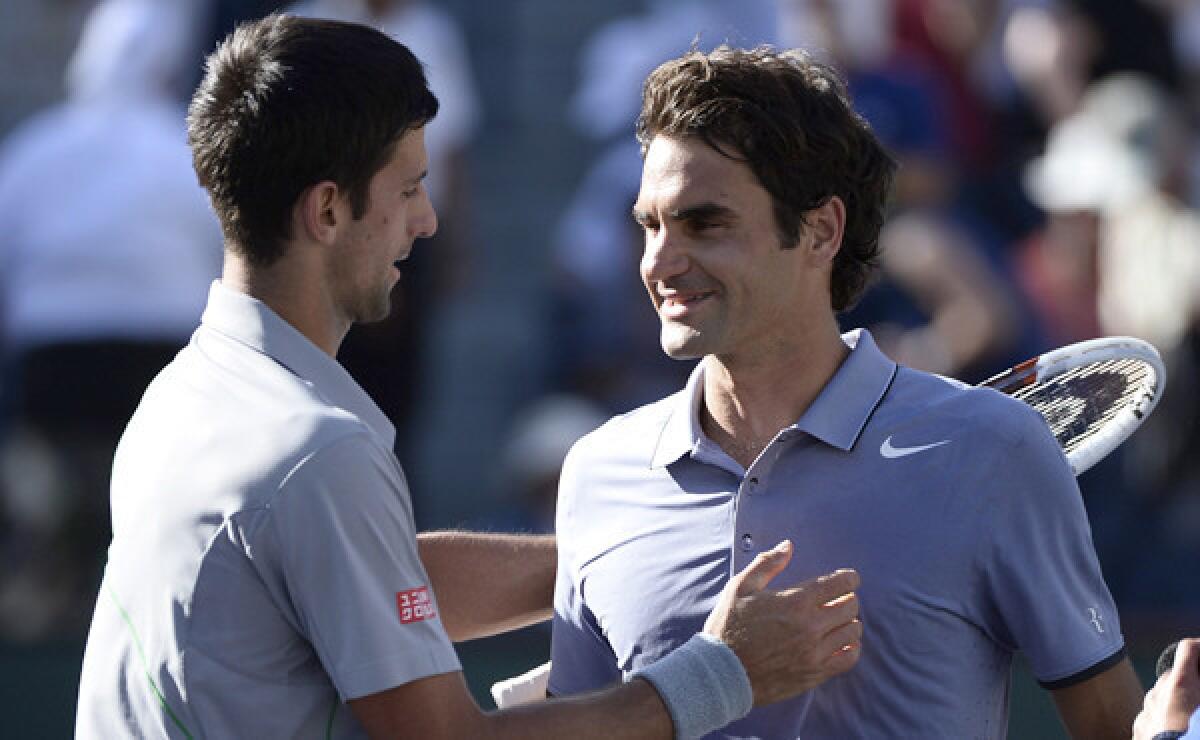Novak Djokovic wins BNP Paribas Open — but Roger Federer doesn’t lose

- Share via
Novak Djokovic proved Sunday at Indian Wells, in the men’s final of the BNP Paribas Open, that Roger Federer does not walk on water.
But then, Djokovic would be the first to admit that his older tennis rival does pretty well on hard courts amid the desert sand.
The grand finale of this grand tournament ended up with Djokovic winning and, somehow, Federer not losing.
Yes, the score went the way of the smooth-moving Serb, 3-6, 6-3, 7-6 (3), and so did the winner’s trophy and $1-million first prize. But the real winner was the sport these two icons represent so well, the sport to which they bring the kind of excitement and buzz that draw a two-week attendance of 431,527 (403,904 paid) through the gates of a place two hours from a major city.
On men’s and women’s finals day — after the women’s final fizzled into a yawn with an injury to one of the players — Djokovic and Federer entered to ratchet up the desert drama.
Djokovic is 26, has won six major titles and the first prize at Indian Wells three times. He is No. 2 in the world and in the prime of his career. Much more to come from him.
Federer is 32, has won a record 17 major titles and with them the general designation as the greatest ever. He was looking for a fifth Indian Wells title. But his age, and a back injury in 2013 that dropped him to No. 8 in the rankings, made his charge through this draw, without losing a set until Sunday, somewhat surreal.
With the victories here came the quick return of the mystique.
A few days ago, Federer sat in an outside dining area and watched a desert wind-and-sand storm blow through the area, swirling and kicking up so much debris that it blocked the view of the distant mountains and wreaked havoc with a women’s match on the main court. Federer, with his dry sarcasm, remarked, “It is the end of the world.”
Two hours later, the storm was gone, the night was a warm delight, and it was time for Federer to take the court. There was conjecture that this was not a coincidence.
That is the aura. The reality is that he is still a great tennis player and that, win or lose, his legend grows.
Such was the case at the 1-hour 53-minute mark of Sunday’s match. That’s when Djokovic stepped to the line to serve for the match at 5-4 of the final set.
The main stadium that seats 16,100 had close to that number on its feet. It might have been the loudest this place has ever been. A jet plane, passing 1,000 yards overhead, wouldn’t have been heard.
It was a stadium of goose bumps. For the previous 30 minutes or so, they had been witness to some of the finest tennis ever played on this prestigious court. The groundstokes were hit harder, the angles of the shots became more pronounced, the lines were hit constantly. These were two athletic artists, painting their own Sistine Chapel.
Those in the crowd knew what they were seeing, felt it, savored it, wanted to express it. They loved Djokovic. They loved the great tennis. They loved that they were lucky enough to be there to see it. But mostly, they loved Federer.
He knew it and acknowledged it later.
“That’s gold,” he said. “It’s beautiful.”
Quickly, despite Djokovic’s being in the middle of a run of some of the best ball-striking seen here, an attacking Federer got it to love-40. And on the second break point, he forced Djokovic to hit wide.
Federer pumped his fist, Djokovic set his jaw and the crowd went crazy. It was clear now. This was meant to end in a third-set tiebreaker. The players’ talents, and the crowd’s frenzy, would allow nothing else. Adrenaline flowed freely, maybe in the crowd more than on the court.
When the tiebreaker arrived, and played out less dramatically — with Djokovic jumping to a big lead with the help of the wind at his back, the same side from which Federer had achieved his break — it was all right.
On match point, Federer’s routine backhand settled into the net, and Djokovic had a well-earned victory, one that showed great mental toughness in a tournament in which he was stretched to three sets three times in six matches.
“I am proud to win this tournament and all I have achieved,” he said. “. . . This was necessary for my confidence.”
In the postmatch ceremony, Federer, the runner-up, got the microphone first. He said all the right things, thanked all the right people. He is now the elder statesman with a 25-year-old forehand.
Djokovic did the same. He had held off a Federer who is playing at nearly the level he did when he was the unbeatable, untouchable No. 1 in the world virtually all the way from 2004 through 2009. Djokovic knew that by achieving what he had, in the arena and setting where he achieved it, there are great days ahead in 2014.
Both players now head to the next big tournament in Miami.
Djokovic said he hoped to keep his winning ways going.
Federer said nothing about stopping on the way to multiply some loaves and fishes.
More to Read
Go beyond the scoreboard
Get the latest on L.A.'s teams in the daily Sports Report newsletter.
You may occasionally receive promotional content from the Los Angeles Times.











